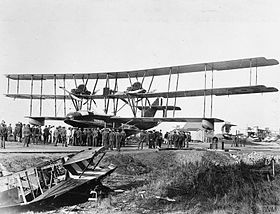avia.wikisort.org - Avion
Le Felixstowe F.4 Fury, également connu comme le Porte Super-Baby, est un grand hydravion triplan à cinq à moteur britannique conçu par John C. Porte à Felixstowe.
|
Felixstowe Fury
| |
 Felixstowe Fury | |
| Constructeur | |
|---|---|
| Rôle | Hydravion |
| Statut | Abandonné |
| Premier vol | |
| Date de retrait | |
| Nombre construits | 1 |
| Équipage | |
| 7 | |
| Motorisation | |
| Moteur | Rolls-Royce Eagle VIII |
| Nombre | 5 |
| Type | 12 cylindres en V |
| Puissance unitaire | 334 ch |
| Dimensions | |
| Envergure | 37,5 m |
| Longueur | 19,26 m |
| Hauteur | 8,38 m |
| Surface alaire | 288,8 m2 |
| Masses | |
| À vide | 8 438 kg |
| Avec armement | 11 483 kg |
| Performances | |
| Vitesse maximale | 156 km/h |
| Plafond | 3 660 m |
| modifier |
|
Inspiré du Curtiss Wanamaker Triplane et du Felixstowe F.5, il s'agit du plus grand avion britannique des années 1910.
Le prototype est détruit lors d'un accident le .
- Portail de l’aéronautique
- Portail du Royaume-Uni
На других языках
[en] Felixstowe Fury
The Felixstowe F.4 Fury[2] (serial N123), also known as the Porte Super-Baby, was a large British, five-engined triplane flying-boat designed by John Cyril Porte at the Seaplane Experimental Station, Felixstowe, inspired by the Wanamaker Triplane/Curtiss Model T. At the time the Fury was the largest seaplane in the world, the largest British aircraft,[3][2] and the first aircraft controlled successfully by servo-assisted means.[1]- [fr] Felixstowe Fury
Текст в блоке "Читать" взят с сайта "Википедия" и доступен по лицензии Creative Commons Attribution-ShareAlike; в отдельных случаях могут действовать дополнительные условия.
Другой контент может иметь иную лицензию. Перед использованием материалов сайта WikiSort.org внимательно изучите правила лицензирования конкретных элементов наполнения сайта.
Другой контент может иметь иную лицензию. Перед использованием материалов сайта WikiSort.org внимательно изучите правила лицензирования конкретных элементов наполнения сайта.
2019-2025
WikiSort.org - проект по пересортировке и дополнению контента Википедии
WikiSort.org - проект по пересортировке и дополнению контента Википедии